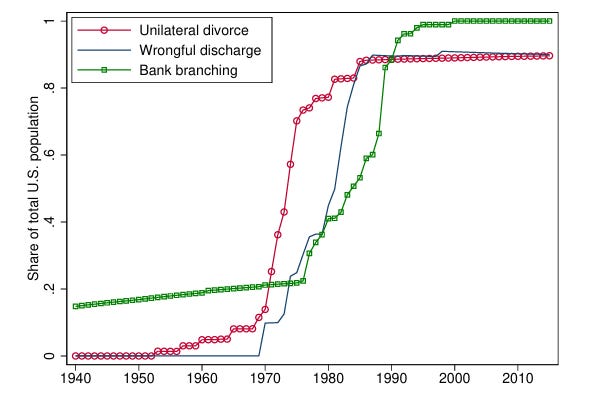Started in the 1970s.
We tend to think of the US as a super-litigious society where billboards advertise the services of accident or employment lawyers. However, as a quantitative analysis of the US legal services economy demonstrates, this wasn't always the case.
The chart below shows that between 1850 and 1970, the share of lawyers and other professionals working in legal services was relatively constant. Then, between the 1970s and 1990s, their share doubled. Meanwhile, their wages relative to the average wage in the private sector also more than doubled.
Employment shares and relative wages of legal services
Source: Reshef and Slattery (2025)
What drove this massive change? The second chart gives an important hint. The number of civil cases under litigation tripled(!) in the same period.
Employment shares and litigation
Source: Reshef and Slattery (2025)
Correlation is not causation, as they always say, and, in this case, it isn’t clear if more cases create more lawyers or if more lawyers generate more cases. If you subscribe to the latter causation, the old joke “What are 50 lawyers tied together at the bottom of the ocean? A good start” sounds more like a piece of policy advice.
If any American lawyers are reading this, Please don’t sue me. I was kidding.
However, the reverse correlation can be argued: more cases require more lawyers, which is why the employment share of lawyers has increased.
In the 1970s and 1980s, the legal landscape in the US changed significantly across various domains. Most notably, state legislatures passed laws in three key domains.
First, laws were changed to allow for ‘no fault divorce’, meaning it became easier for spouses to end a marriage and split their assets.
In Germany and many other civil law societies, legal insurance covers legal expenses in case you are sued. This is possible because lawsuits cost much less in these countries since lawyer fees are heavily regulated. However, two exceptions are not covered by legal insurance: divorce and inheritance. Insurance companies know that when it comes to divorce proceedings, the gloves come off…
Second, in the 1970s and 1980s, labour laws were changed to give employees more rights to fight against wrongful terminations. And you can guess what happens when an ex-employee with an axe to grind meets a lawyer who needs fee income.
Finally, state regulators allowed banks to acquire new branches through mergers and acquisitions. This increased competition between banks and created employment opportunities for corporate lawyers and tort lawyers alike. The third chart shows the share of the US population that was affected by these three changes in the legal framework.
State-level legislation and regulation
Source: Reshef and Slattery (2025)
In short, by giving people more opportunities to complain and bring their grievances to court, politicians reaped what they sowed: more litigation and lawyers.







A vast number of politicians in the English-speaking world are laywers.
Since these people who make the laws, is democracy just a job creation scheme for the legal trade?
Your theory about the 3 key domains doesn't seem very compelling. Do you have any evidence to suggest that the rise in disputes for divorce, employment and banking M&A has been significantly greater than the rise in other types of disputes?
It seems more plausible to me that there are other reasons for the rise in litigation during the 1990s - e.g. change in laws around how lawyers could advertise or be compensated, or change in personal injury laws, or some other changes in civil procedure rules that might have increased workloads.
For example, in 1977 the Supreme Court ruled in *Bates v State Bar of Arizona* that state bar ethical codes that prohibited lawyers from advertising their services was a violation of the First Amendment protecting speech. That seems to me to be a far more likely reason for the increase in America's litigiousness - particularly because many other countries (UK, Canada, Australia, NZ) continue to have strict restrictions on legal advertising and contingency fees but are much less litigious. (I also note those other countries tend to have more employee protections than the US, so I find it implausible that the changes in labour laws caused the proliferation of litigation.)